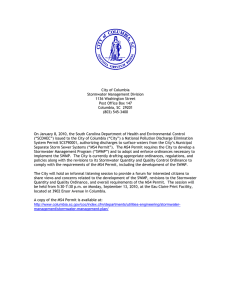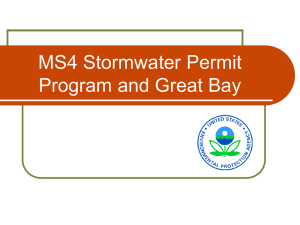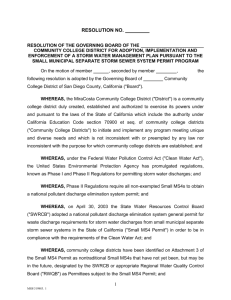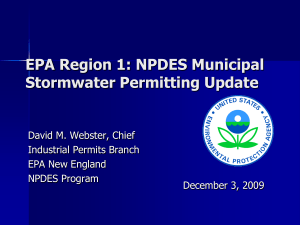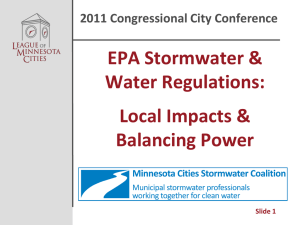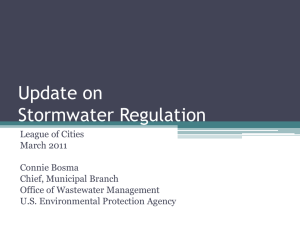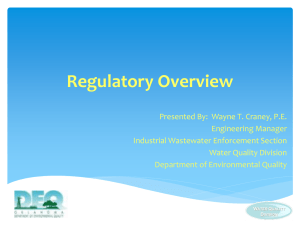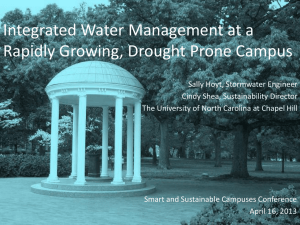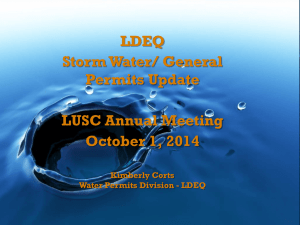SH-Mtg-NYC-MS4-Presentation_6_2
advertisement
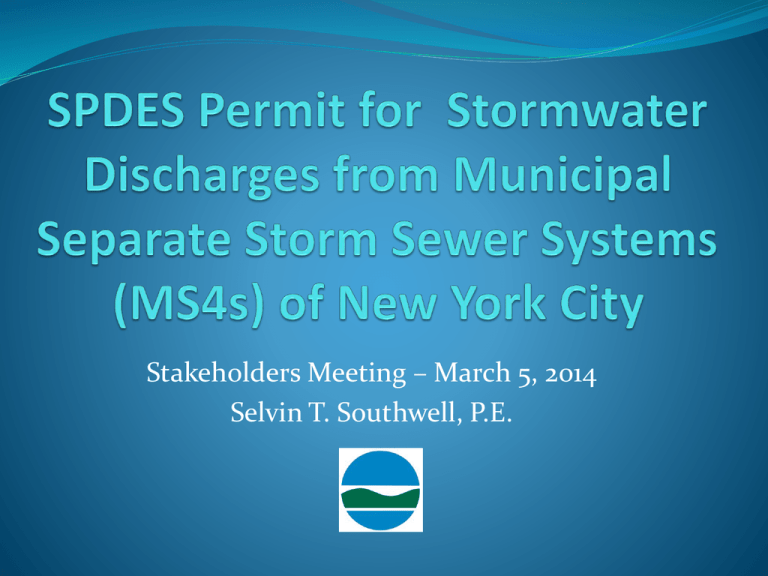
Stakeholders Meeting – March 5, 2014 Selvin T. Southwell, P.E. MS4s in New York City NYCDEP Drainage Areas with MS4s Staten Island, including Bluebelts (Most of the borough except North East and North Central) Queens (South, East, North East, Rockaways) Brooklyn (South) Bronx (East) Other City Agency Drainage Areas with MS4s Industrial facilities and construction sites in direct drainage areas (along waterfront/ shoreline) Municipal operations/facilities in direct drainage areas MS4s in New York City – Cont’d Fifty one percent of New York City’s (NYC) land area represents separate sewered areas, direct discharge areas, and unsewered areas Of the NYCDEP’s sewered areas, 35 percent have a separate sewer system NYC municipal separate sewer system (MS4) serves a population of about 2 million and is a large MS4 as per the Federal Regulations [40 CFR Part 122.26(b)] Basis for the Permit Stormwater requirements for large MS4s in the Federal Regulations [40 CFR 122.26(d)] formed the basis for the Permit Additionally, the following sources were consulted: NYSDEC SPDES General Permit for Stormwater Discharges from MS4s (GP-0-10-002), May 2010 EPA Audits of Tallman Island & Oakwood Beach WPCP MS4s EPA’s MS4 Improvement Guide [Publication 833-R-10-001], April 2010 MS4 Permit programs from large cities such as Philadelphia, Los Angeles, Chicago, Houston, District of Columbia Intent of the Permit The intent of this SPDES permit is to manage urban sources of stormwater runoff to protect overall water quality and improve water quality in impaired waters as part of a comprehensive integrated planning approach that considers non-MS4 sources and planned controls for those sources Stomwater Management Program Plan (SWMP) The City will be required to develop a SWMP within three years of permit issuance public education and participation illicit discharge detection and elimination construction and post-construction runoff industrial user and industrial source control program municipal operations and facilities floatables control stormwater monitoring Impaired Waters The City will be required to develop a program to ensure no net increase of pollutants of concern (POC) to impaired waters resulting from non-negligible land use changes non-negligible land use changes - land disturbances greater than or equal to 1 acre where there is an increase in impervious cover Legal Authority The City will be required to develop and maintain the authority to carry out all aspects of their stormwater management programs control of pollutants flowing into the MS4 access to inspect sources of pollutant discharges procedures to ensure compliance escalating enforcement mechanism in the event of violations Legal authority will be required for: construction site runoff control post-construction runoff control industrial and commercial site inspections illicit discharge detection and elimination programs Implementation of SWMP – Key Requirements Compliance schedule for SWMP development and implementation Tracking system to track the information required in the Permit Reporting requirements after SWMP is developed to demonstrate that the SWMP is implemented and is effective Construction & Post-Construction Stormwater Quality Controls The City must develop, implement, and enforce a program equivalent to SPDES Construction Stormwater General Permit to reduce pollutants in construction and post construction runoff to MS4s from new development and redevelopment projects with land disturbance of greater than or equal to 1 acre (except direct drainage areas) Combination of structural and/or nonstructural best management practices (BMPs) can be used For post-construction stormwater runoff, Green Infrastructure (GI) practices can be implemented Green Roofs, Rain Gardens, Stormwater Planters, Rain Tanks/Cisterns, Porous Pavement, Riparian Buffers/Filter Strips, Vegetated Swale, Tree Planting Infiltration, Bioretention, Dry Swale Develop procedures for SWPPP reviews and acceptance Establish and maintain an inventory of post-construction stormwater BMPs including practices authorized since 2003 Ensure adequate long-term operation and maintenance of controls Industrial Stormwater Quality Controls The City must prepare and maintain an inventory of industrial and commercial sources that could discharge POCs in stormwater The City must maintain full oversight and control of these facilities including inspections and enforcement Develop procedures for site inspection, compliance, and enforcement of SPDES MSGP facilities (except direct drainage areas) Develop a plan to inspect and assess unpermitted industrial and commercial facilities that generate significant contributions of POCs to impaired waters Pollution Prevention from Municipal Operations/Facilities The City must develop and implement a pollution prevention/ good housekeeping program for municipal operations and facilities, including: Street and Bridge maintenance Winter Road maintenance including deicing activities Catch basin cleaning Vehicle and Fleet maintenance Park and Open Space maintenance Solid Waste Management Marine Operations Develop program to control and reduce to the MEP the application of pesticides and fertilizers Require municipal facilities subject to MSGP requirements to meet substantive requirements of the MSGP Floatable Controls The City must continue to implement existing or improved controls to reduce floatables and settleable solids from the MS4 areas to waterbodies The City must also develop a methodology to determine baseline floatable load and identify the best available control technologies that can be implemented The City must evaluate their existing programs and determine how/if they should be modified to meet the objective of minimizing the discharge of floatable materials from their MS4s Once methodology is approved, the City will have 2 years to commence the study to determine the baseline load Stormwater Monitoring The proposed permit requires the City to develop a Monitoring & Assessment Program. The City will be allowed to expand on existing programs or propose new methods to assess the effectiveness of their SWMP to meet the following objectives: Assess compliance with the permit Measure the effectiveness of the SWMP Characterize and assess quality of discharges at representative outfalls Identify sources of specific pollutants Detect and eliminate illicit discharges Evaluate long term trends The Monitoring and Assessment Program will be customized to specific waterbodies, impairments, and pollutant sources of the MS4 The City is required to implement the Monitoring and Assessment Program to assess potential sources of discharge of stormwater POCs, identify potential additional reduction measures for POCs, and evaluate its progress in addressing the POCs Significant Benefits Inspection and enforcement program will prevent pollutants from industrial, commercial, and construction sites Improved program to detect and eliminate illicit discharges to the MS4 and to the waterbodies A targeted program to minimize garbage, litter, and other floatables from the MS4 areas Best management practices to eliminate or reduce pollutants from NYC’s municipal operations and facilities Public education requirement will result in elimination of some pollutants at their sources Improved program to assess and monitor stormwater discharges from MS4s Timeline for Permit Issuance The draft Permit was public noticed on February 5, 2014 Public had 30 days to comment on the draft Permit, but it is being extended for 30 more days to April 7, 2014 NYSDEC responds to the public comments and compiles a Responsiveness Summary If no hearing is held, NYSDEC makes its final decision on the Permit application within 120 (90+30) days of public noticing If a hearing is held, the NYSDEC notifies the Permittee and the public of a hearing within 90 (60+30) days of public noticing – the Permit cannot be issued until the hearing process is completed
